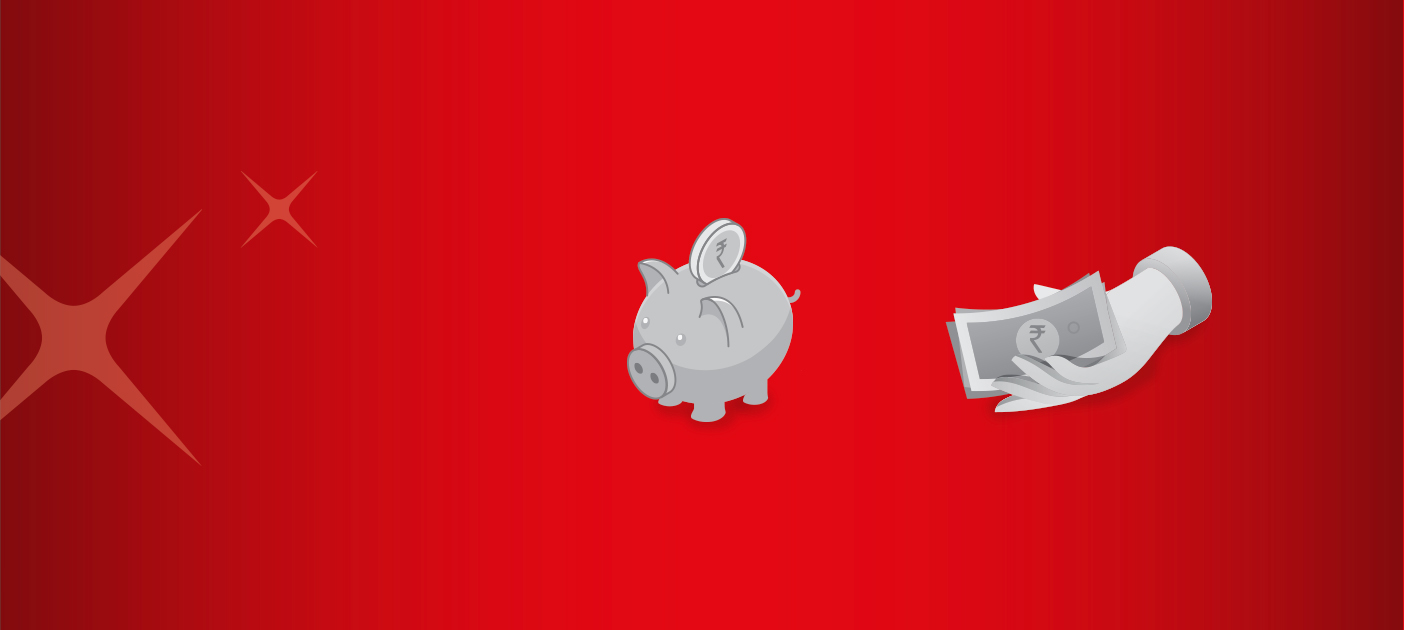- Save
- Invest
- Borrow
- Pay
- More
- Customer Services

Difference Between Checking and Savings Account
Understanding the Difference Between Savings and Checking Accounts
Key Takeaways
- Savings and Checking Accounts are two of the most common products offered by banks and other financial institutions, yet they differ in many ways.
- Checking Accounts typically yield little to no interest, whereas Savings Accounts accrue interest.
- Savings Accounts may have restrictions on cash withdrawals, but Checking Accounts allow unlimited cash withdrawals and deposits.
- The frequency of transactions differs between a Savings Account vs. Checking Account.
- Maintaining higher balances is necessary for Checking Accounts compared to the considerably lower balances required for Savings Accounts.
Introduction
In times of inflation and rising expenses, being financially prepared is more important than ever.
When it comes to effectively managing your capital, you have a choice between two main types of accounts: Savings and Checking Accounts. These serve distinct purposes in personal and business finance.
A Savings Account offers a secure way to save money while earning interest, perfect for achieving personal financial goals. On the other hand, a Checking Account provides easy access to daily transactions, making it ideal for managing frequent deposits and withdrawals, especially in business environments.
This blog post will explore the key differences between Savings and Checking Accounts, helping you decide where to allocate your funds wisely.
What is a Savings Account?
A Savings Account is designed for saving and increasing your capital through regular deposits. It is a place where you can park the money you do not need right away. Unlike Checking Accounts, Savings Accounts have limitations on withdrawals. Typically, there's a monthly cap on transactions through banks and ATMs. Upon opening this account, you get a debit card, passbook, cheque book, and internet banking services. This account allows you to earn a semi-annual or annual interest payout on the deposited funds, helping you grow your savings over time.
You can use a Savings Account for:
- Building an emergency fund for unexpected expenses, like car repairs or medical bills.
- Reaching short-term goals, such as saving for a down payment on a car, house, or vacation.
- Managing regularly recurring expenses like property taxes or insurance premiums.
- Growing a nest egg for retirement or other long-term goals.
- Saving for children's education.
- Parking extra cash to accrue interest over time.
What is Checking Account?
A Checking Account, also known as a Current Account, is a type of bank account used for everyday expenses. These accounts are easy to access and have no withdrawal limits associated with them. Upon opening the account, you receive a debit card, a cheque book, and a passbook from the bank. Additionally, you can manage your funds through online and mobile banking services, ensuring access anytime and anywhere. However, unlike Savings Account, these accounts typically offer minimal to no interest benefits for depositors.
Checking Accounts are a great way to manage your day-to-day finances. You can use them to:
- Pay bills electronically or with cheques
- Make purchases with a debit card
- Deposit paychecks or cash
- Transfer money to other accounts
Difference Between Savings and Checking Accounts
Understanding the difference between Savings and Checking Accounts is crucial before opening either.
-
Account Fees
Banks charge you a fee for most transactions carried out through your Checking Account – ATM fee, overdraft protection fee, overdraft fee, online access fees, etc. On the other hand, a Savings Account is almost free from any kind of fee. The only time a bank will charge you a fee is if you exceed the money withdrawal limit or fail to fulfil the minimum balance requirements set by the bank.
-
Frequency of Transactions
If you have a Checking Account, you are required to carry out at least one transaction each month. If you fail to do so, your bank will levy a monthly maintenance fee. As for Savings Accounts, you can carry out a transaction once every six months to keep your account active. If there is no activity on your account (and the debit card provided with it), the bank will treat it as dormant.
-
Frequency of Usage
You can deposit and withdraw money from your Checking Account as often as you like. You may even carry out multiple transactions per day, as there is no upper limit on deposits and withdrawals. However, with Savings Accounts, there are certain restrictions on the number of times you can withdraw money at banks and ATMs. You must also pay additional charges for using other bank ATMs if you exceed the 3-5 permitted transactions each month.
-
Interest Payout
The interest rate offered is the most significant difference between the Savings and Checking Accounts. Banks usually provide little to no interest on Checking Accounts. With Savings Accounts, you earn interest on your deposits. The interest rate differs from bank to bank and largely depends upon the type of Savings Account you open and the sums you deposit in it.
Here's a table to summarise the difference between Savings Account vs. Checking Account:
|
Features |
Savings Accounts |
Checking Accounts |
|
Primary Purpose |
Primarily for saving money and earning interest |
Used for daily transactions and bill payments |
|
Interest Rates |
Typically earns interest |
Minimal to no interest at all |
|
Withdrawal Limits |
Limited withdrawals |
Unlimited withdrawals |
|
Ideal For |
Both short and long-term financial goals (emergency fund, down payment on a house) |
Everyday spending needs (bills, groceries, gas) |
|
Minimum Balance Requirements |
May require a minimum balance for interest |
Often has a minimum balance requirement |
|
Transaction Limits |
Limited to certain transactions per month |
No limits on the number of transactions |
|
Fees |
Generally fewer fees compared to checking |
Can have higher fees for overdrafts and usage |
Download digibank today to experience the benefits of Digital Savings Account.
Savings Account vs. Checking Account: Which Is Better?
Before choosing between a Savings Account vs. Checking Account, you should first consider your needs and banking habits.
Savings Accounts are ideal for saving money and growing it over time. They offer higher interest rates than Checking Accounts but may limit the number of withdrawals you can make each month. Savings accounts are a good fit for saving for short-term or long-term goals.
Checking Accounts, on the other hand, are for everyday transactions, such as bill payments and debit card purchases. They offer easy access to your money and may not have limitations on the number of withdrawals. However, they typically have lower interest rates or no interest at all.
How to choose the best Checking and Savings Account?
Now that you know the difference between Savings and Checking Accounts, let us look at the factors you should consider while opening either type of account. Here's what you need to do to select the best account for your needs.
-
Check the Interest Rates:
Consider the interest rate offered by the bank on both Checking vs Savings Accounts. Typically, PSU banks offer lower interest rates with annual interest payout, whereas private sector banks offer slightly higher interest rates with semi-annual interest payout.
-
Check the Minimum Balance Requirement:
All banks have different minimum balance requirements on both Savings and Checking Accounts. Typically, Checking Accounts require higher minimum balances, while Savings Accounts can range from ₹500 to ₹100,000, depending on the account type.
-
Check the Presence and Platforms of Banks Offering the Accounts:
Ensure your bank has a significant presence, not only in your city and country but also internationally. A reliable bank offers diverse platforms for accessing your funds, including internet, mobile, and SMS banking services, along with extensive ATM networks, accessible customer care helplines, designated relationship managers, and more.
The Bottom Line
Knowing the difference between Savings and Checking Accounts can help you confidently choose the account that suits you best. The ultimate decision to enrol in either account depends mainly on your needs and goals.
Remember, no rule says you cannot open both accounts if it benefits your financial strategy. Like every crucial life decision, make sure to assess the pros and cons of both accounts before choosing one for your banking needs.
With DBS Bank app, you can open a new Savings Account in a few minutes! Download the app to get started.
Frequently Asked Question
-
How Much Fund Should You Have in Your Checking Account?
The amount you should keep in your Checking Account depends on several factors. If your bank mandates a minimum balance, you should maintain at least that amount to avoid service charges that can reduce your balance. It's also wise to keep enough to cover one to three months of expenses in your Checking Account for emergencies, ensuring you can cover your living costs and bills.
-
What is Required to Open a Checking or Savings Account?
To open a Checking or Savings Account, you'll typically need:
- A valid identity proof (like an Aadhaar card, passport, voter ID card, driving licence, and employee ID card issued by a reputable organisation)
- Proof of address (such as a passport, utility bills not older than two months, bank statement from another bank, rental agreement, or ration card)
- Two recent passport-sized photographs
- Lastly, if there's a minimum deposit requirement, you must bring that amount with you. This amount can vary depending on the bank and account type.
-
How Secure are Savings and Checking Accounts?
Savings and Checking Accounts are highly secure compared to carrying cash. Banks provide built-in security features like passwords, protection against unauthorised transactions, and strong online security measures such as firewalls, encryption, and multifactor authentication. These features help prevent identity theft and fraud, making bank accounts safer for managing your money.
*Disclaimer: This article is for information purposes only. We recommend you get in touch with your income tax advisor or CA for expert advice.








